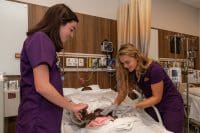Caring, supportive mentors can help ease faculty shortage.
Takeaways:
- Mentoring is one strategy to help solve nursing faculty shortages.
- Good mentors lie at the heart of every good mentorship program.
- Mentors and mentees must be carefully matched to ensure that a positive relationship develops.


One way to solve the faculty shortage may be mentoring, which helps to foster collegial and caring environments for novice educators to promote success and retention. To explore this idea, I conducted a study to identify characteristics important to mentorship programs. (See Mentoring study.)
Mentoring study
| The mentoring study included semistructured interviews with six novice faculty from three universities to learn about their mentoring experiences. From participants’ perspectives, mentoring helped build skills, knowledge, confidence, and socialization. Their mentors helped them: • understand the various roles of an educator |
Care, connect, communicate
At the heart of every good mentorship program is good mentors. A successful mentoring relationship incorporates caring, connecting, and communicating components. Study participants defined caring and supportive characteristics in a variety of ways; some defined it as someone they liked to hang out with “off the record” just to talk. Others described the reassurance they felt when a mentor closed the office door and didn’t answer phone calls when they wanted to talk or when the mentor didn’t seem bothered when they needed support.
For mentorship programs to be successful, mentors and mentees must be carefully matched to help a positive relationship develop. Most of the study participants felt that their mentor was selected carefully for them. Others expressed appreciation for mentors who volunteered, saying that it indicated interest in the success of the new faculty not just because they were needed but also because the mentors truly cared. (See Characteristics of a good mentor.)
Characteristics of a good mentor
The following mentor characteristics were described by study participants as influencing their decision to continue teaching:
|
Components of a good mentorship program
Successful mentorship programs have guidelines and an evaluation process. Mentors should be chosen based on their willingness to participate in the program and their ability to provide caring support in service to mentees’ success. The program should include mentor training and guidelines for carefully matching mentors with mentees.
All mentors should schedule regular time to meet with their mentees to offer advice and guidance and review progress reports. In addition to advice about teaching, research, and scholarship, mentors should offer guidance related to work–life balance and socialization within the school of nursing. In addition, a good mentoring program thrives when the institution stays up-to-date about advances in mentoring.
Supporting novice faculty
The path to a strong nursing workforce requires robust nursing education that includes dedicated faculty. Formal mentoring programs can aid in building and retaining nursing faculty, providing the support novice faculty need to gain the confidence and skills required for educating future nurses.
Stephanie W. Terry is the program director of nursing at Bryant & Stratton College—Hampton Virginia Campus.
Selected references
American Association of Colleges of Nursing. Nursing shortage fact sheet. 2017.
Baker SL. Nurse educator orientation: Professional development that promotes retention. J Contin Educ Nurs. 2010;41(9):413-7.
Ingeno L. Nursing schools face faculty shortage. Inside Higher Ed. 2013.
Institute of Medicine. The future of nursing: Focus on education. 2011.
National League for Nursing. Position Statement: Mentoring of Nurse Faculty. 2006.
Robert Wood Johnson Foundation. Mentoring: A boon to nurses, the nursing profession, and patients too. 2013.
Waldrop J, Chase S. Lead faculty workload model: Recognizing equity and leadership in faculty. Nurse Educ. 2014;39(2):96-101.



















1 Comment.
Awesome article, Dr. Terry. I referenced this article in one of my recent online discussion posts. I am so very proud of your work. I hope you and the family are doing well.